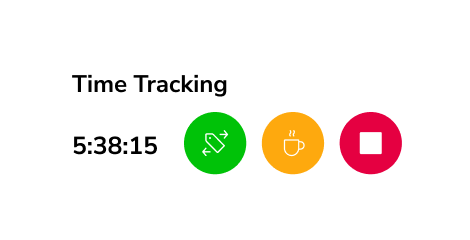How to Upgrade Desktop Time Tracking with Integrations
2025
The workplace is evolving and so is the way employers track time. A majority of employers are already using some form of monitoring software to track employee performance, online activity, and of course, their time. From the early days of manual time cards, employers now have access to a wide array of time tracking apps available on mobile, web, browser, and even right from their desktops!
Desktop time trackers offer an especially convenient way to track work hours and productivity. It can do most if not everything that your typical web time tracker can do – but the advantage is that it’s directly integrated into your desktop environment. Desktop time tracking tools can also let you track time offline and offer a higher level of employee monitoring with features like screenshot monitoring, URL tracking, and keyboard activity tracking.
Now, desktop time trackers are already great in themselves, but what if I tell you they could be even greater? Enter integrations – the key to upgrading your desktop time tracking experience.
You can think of integrations as power-ups for your desktop time tracker. They allow you to link it with all your essential work apps, creating a seamless, efficient work environment. If you’re not using desktop integrations yet, you’re missing out! But don’t worry, it’s never too late to upgrade your desktop time tracking experience with these nifty tools.
In this article, I’m going to be giving you a better look at what integrations are, their many benefits, and how you can set them up with your desktop time tracking software to supercharge your productivity and streamline your workflow.

Photo by Bench Accounting on Unsplash
What are Desktop Time Tracking Integrations, Anyway?
App integrations connect different software tools so they can work together and share data—like linking your desktop time tracker with other apps you use for work.
For example, the Jibble time tracking app can be integrated with tools like Asana and Trello, so your time entries sync automatically, no more manual updates.
It also connects with payroll and accounting apps like Deel, ADP, QuickBooks, and Xero to simplify payments and invoicing.
Integrations are made possible through various methods, including APIs (Application Programming Interfaces), webhooks, and custom connectors. These technologies serve as the backbone for data exchange between different applications, enabling them to work together in harmony.
What are the Benefits of Using Desktop Time Tracking Integrations?
When choosing a desktop time tracking app, one of the main things you need to look for is its ability to integrate with the tools you already have in your workflow.
Why, you may ask? Well, having seamless integrations with your existing software offers a host of benefits. Here’s a look at just some of them.
1. Efficiency and Productivity Boost
Integrating your desktop time tracking app with other essential tools in your workflow eliminates the need for manual data entry. If you work on multiple projects throughout the day, you can integrate your desktop time tracking app with project management platforms, such as Trello, Asana, or Jira, to seamlessly allocate your hours and tasks.
You can also integrate your desktop time tracker with payroll or accounting apps so time data is automatically translated into precise payroll calculations or invoicing information.
This automation saves a significant amount of time that would otherwise be spent constantly switching between apps.
2. Accurate and Reliable Data
It’s frustrating when the time data on your desktop time tracker doesn’t match the hours on your employee payroll or client invoice. You might end up underbilling or overbilling clients.
Thankfully, integrations can ensure that data is consistently accurate and up-to-date across all connected systems. Any time data changes you make on your desktop time tracking app is synced in real-time to your integrated tools. And when time tracking data seamlessly flows into project management, invoicing, or payroll tools, you can trust that the information is error-free.
3. Improved Collaboration and Communication
Integrations facilitate better collaboration within teams while streamlining the time tracking process further. Jibble’s desktop app, for instance, lets users seamlessly track time without having to leave Slack or MS Teams. It also has handy shortcuts that can make clocking in and out via collaboration platforms a breeze.
When time tracking tools like Jibble are seamlessly integrated with project management and communication tools, team members have real-time visibility into project progress, deadlines, and resource allocation. This transparency fosters effective teamwork, ensures everyone is on the same page, and helps in meeting project milestones.
How to Set Up Integrations with Your Desktop Time Tracker
It’s clear now how integrations can significantly enhance your overall desktop time tracking experience. The next step is to learn how to set them up so you can start enhancing your productivity and efficiency.
There are two primary methods for achieving this: using direct integrations available within the app and leveraging APIs (Application Programming Interfaces). The latter is a tad bit more complex so I’m going to focus on the direct integrations.
Every desktop time tracker may have a slightly different process for setting up direct integrations, so for this section, we’ll focus on how it’s done in the Jibble desktop app.
- Open your time tracking app and go to the Settings or Integrations section.
- Browse the available integrations—you’ll see a list of apps like Asana, Trello, QuickBooks, and more.
- Choose the app you want to connect to.
- Follow the setup steps, which will involve logging in to the other app and allowing access.
- Adjust any settings if needed, like choosing which projects or clients to sync.
- Test the connection to make sure everything works smoothly.
Final Takeaways
Integrations offer a gateway to unleashing the full potential of your desktop time tracking software. By seamlessly connecting your time tracker to essential work apps, you not only create a streamlined workflow but can also reduce the risk of costly errors.
Try to choose a desktop time tracker that fits seamlessly into your existing tech stack. This ensures that the integration process is smooth and efficient. With direct integrations, you can easily link your time tracker with popular project management tools, accounting software, and communication platforms. If you have the IT expertise necessary, you can also make use of APIs for more customized integration solutions.
Regardless of which way you choose to go at it, leveraging time tracking integrations is definitely a step in the right direction toward an improved desktop time tracking experience.
Not sure if you should go for web or desktop time tracking? Let our article on desktop vs. web time tracking help you make the right decision. Also learn more about desktop time trackers with our comprehensive guide to desktop time tracking.


